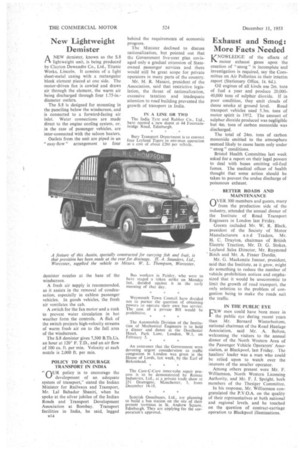New Lightweight Demister
Page 48

If you've noticed an error in this article please click here to report it so we can fix it.
1-1 A NEW demister, known as the S.8 lightweight unit, is being produced by Clayton Dewandre Co., Ltd., Titanic Works, Lincoln. It consists of a light sheet-metal casing with a rectangular block element placed at one side. The motor-driven fan is cowled and draws air through the element, the warm air being discharged through four 1.75-in.diameter outlets.
The S.8 is designed for mounting in the panelling below the windscreen, and is connected to a forward-facing air inlet. Water connections are made direct to the engine cooling system, or, in the case of passenger vehicles, are inter-connected with the saloon heaters.
Outlets from the unit are piped in an " easy-flow " arrangement to four demister nozzles at the base of the windscreen.
A fresh air supply is recommended, as it assists in the removal of condensation, especially in cabless passenger vehicles. In goods vehicles, the fresh air ventilates the cab.
A switch for the fan motor and a cock to prevent water circulation in hot weather form the controls. A flick of the switch projects high-velocity streams of warm fresh air on to the full area of the windscreen.
The S.8 demister gives 7,500 B.Th.Us. an hour at 120° F. T.D., and an air flow of 100 Cu. ft. per mm. Velocity at each nozzle is 2,000 ft. per min.
POLICY TO ENCOURAGE TRANSPORT IN INDIA
"nUR policy is to encourage the 1.--; development of an adequate system of transport," stated the Indian Minister for Railways and Transport, Mr. Lal Bahadur Shastri, when he spoke at the silver jubilee of the Indian Roads and Transport Development Association at Bombay. Transport facilities in India, he said, lagged
behind the requirements of economic progress.
The Minister declined to discuss nationalization, but pointed out that the Government five-year plan envisaged only a gradual extension of Stateowned passenger services and there would still be great scope for private operators in many parts of the country.
Mr. M. R. Masani, president of the Association, said that restrictive legislation, the threat of nationalization, excessive taxation and inadequate attention to road building prevented the growth of transport in India.
IN A LINE OR TWO The India Tyre and Rubber Co., Ltd., have opened a new depot at 64 Fountainbridge Road, Edinburgh.
Bus workers in Paisley, who were to have staged a token strike on Monday last, decided against it in the early morning of that day.
Weymouth Town Council have decided not to pursue the question of obtaining powers to operate their own bus service. The cost of a private Bill would be prohibitive.
The Automobile Division of the Institution of Mechanical Engineers is to hold a dinner and dance at the Dorchester Hotel, Park Lane, London, W.1, on February 5.
An assurance that the Government were devoting urgent consideration to traffic congestion in London was given in the House of Lords, last week, by the Earl of Birkenhead.
The Cure-C-Cure inner-tube repair process is to be demonstrated by Romac Industries, Ltd., at a private trade show at 251 Deansgate, Manchester, 3, from December 14-18.
Scottish Omnibuses, Ltd., are planning to build a bus station on the site of their present terminus in St. Andrew Square, Edinburgh. They are applying for the corporation s approval.




















































































































